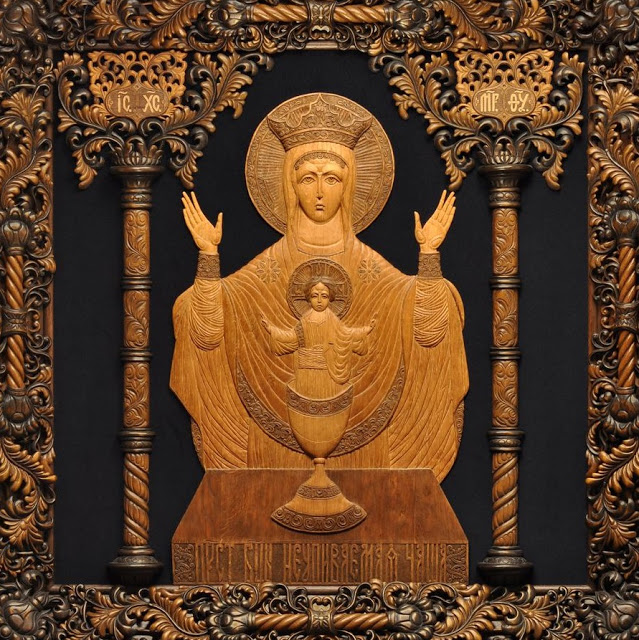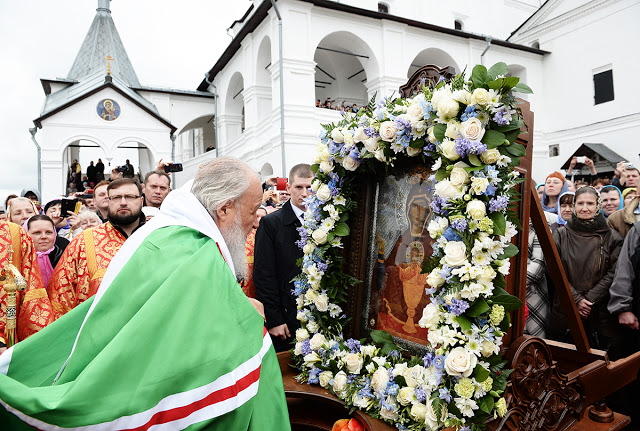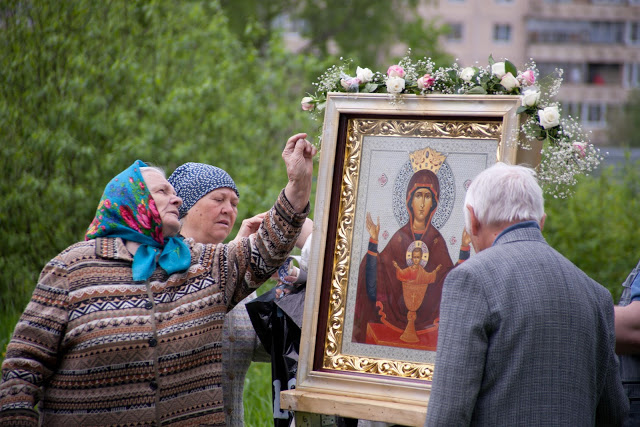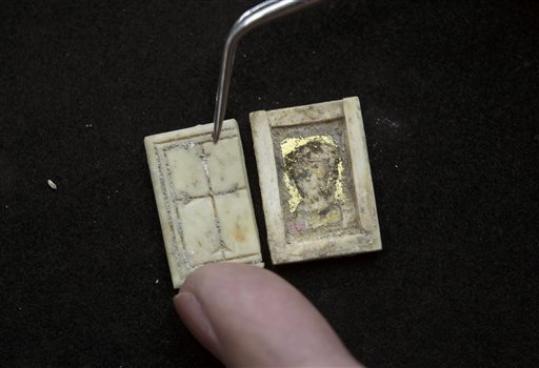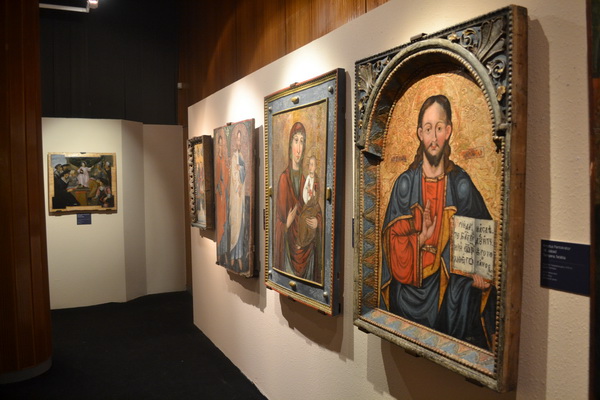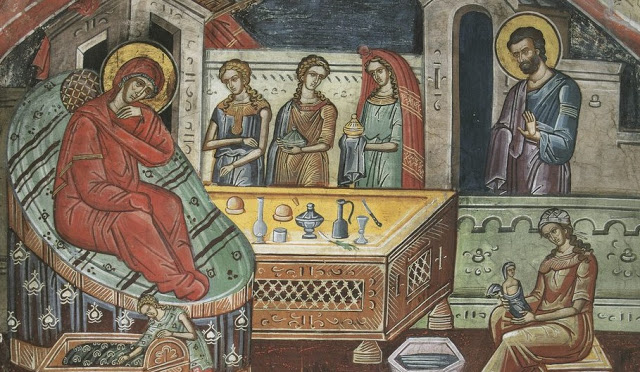Russian icons are, for the most part, essentially copies of prototypes that appeared in different times and places. Some of the prototypes are very old, others comparatively recent. So icon painting is not a matter of originality, but rather a matter of reproduction of an existing image. There may be thousands and thousands of copies of a popular prototype. These copies follow the same general pattern as an original, which we may call a type. Icons of Mary, called the Bogomater — the Mother of God — were particularly popular, so there are hundreds of different Bogomater types.
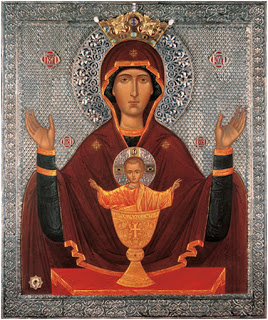
The most popular of these types became so because the original was assumed to be chudotvornaya — “wonder-working,” meaning miracle-working. There are many stories and legends of miracles involving icons of Mary, and such “power” images were given respect beyond that given an ordinary icon, which accounts for the great number of copies made of them.
Even though the original Marian icon may have been considered “wonder-working,” the same could not be said of all of the copies made from it. Unless, that is, a particular copy of the type began to work miracles on its own. Then, curiously enough, it sometimes received its own name, distinguishing it from the original prototype.
There is an interesting icon that became known in the latter part of the 19th century — the icon is that known as the Неупиваемая чаша, (Neupivaemaya Chasha) the “Not-Drink–up-able Cup,” usually more elegantly Englished as the “Unfailing Chalice” or “Inexhaustible Chalice” Mother of God icon.
Now there are two interesting things about this icon. The first is that — unlike the “neo-traditional” style image of it shown above — the popular copies are generally painted in the Westernized style — the more realistic style borrowed from Western European painting, particulary from the 1600s onward, by the Russian State Church, in contrast to the stylized and more abstracted traditional manner favored by the Old Believers, who separated from the State Church in Russia. The version shown above is that venerated presently in the Vysotskiy Monastery in Serpukhov, about 62 miles south of Moscow. It is not the original, which was destroyed.
The second interesting thing is that the “Unfailing Chalice” is visually related to two other icon types. The upper part, depicting Mary with outraised hands and the Christ Child (Christ Immanuel) before her, is virtually that of the “Sign” (Znamenie) Mother of God type. The lower portion, with the Christ Child’s lower body in a eucharistic chalice, is related to the Nikeyskaya (“Nicean”) Mother of God type, which is also called “Your Womb Becomes the Holy Table.”
Now there are prayers to go with these individual wonder-working Marian icons, and one of these would give us the latter “Nikeyskaya” association even if we did not
recognize it. The kontakion, voice 6, associated with this icon begins: “Бысть чрево Твое святая Трапеза…” — “Your Womb Becomes the Holy Table.” Those words mean that when pregnant with Jesus, the womb of Mary became the “holy table,” meaning the altar. This relates to the altar table in Eastern Orthodoxy, on which the eucharistic bread which is considered the body of Jesus — the “Lamb of God” — is placed.
There are several Marian icons with a specific “popular” purpose. One, for example, is used in an attempt to ease childbirth; another is used to ward off fire from a building. The “Unfailing Chalice” has as its purpose the aiding of alcoholics who wish to give up their addiction to drinking.
One sees easily how this association with drinking came about. In the icon there is a (eucharistic) cup/chalice, and out of it proceeds the child Jesus. The Church Slavic inscription visible on it reads: АЗЪ ЕСМЬ ЛОЗА ИСТИННАЯ — AZ ESM LOZA ISTINNAYA, meaning “I am the true vine…” (taken from John 15:1)
The association with wine drunk from a cup, with the concept expanded to include other alcoholic beverages, is a natural link to make. And so this prototype became an “anti-alcoholism” icon believed to have wondrous powers. Large numbers of copies have been made of it in the past few decades, and they are recommended to those with drinking problems.
Now all of this is, of course, a kind of magical thinking, but that kind of thinking — the use of talismans and amulets and so on — is very ancient and found in many religions, and it is sometimes probably even effective for one reason or another.
In any case, the icon has, like most “wonder-working” icons, an interesting origin story. In the hagiography of Marian icons, the important date is the “Appearance” (Yavlenie) of an icon. By “Appearance” is not meant when the icon was first made. It means instead the time at which a particular icon first began to work miracles — its manifestation as a “miracle-working” image.
The “Appearance” of the Unfailing Chalice icon took place in the year 1878, according to its associated story. A certain former soldier of the Efremov division of the Tula gubernia (government/province) was afflicted by a heavy addiction to drinking. He drank away all of his pension, and even lost most of his belongings to alcohol. It got so bad that he even was losing the use of his legs, yet he kept on drinking. And then he had a strange dream.
An old staretz (spiritual elder) in a skhima (monk’s hooded garment) appeared to him, and told him, “Go to the town of Serpukhov, to the monastery of the Entry [into the Temple of the] Mistress Mother of God. There is an icon of the “Unfailing Chalice” Mother of God. Perform a moleben [rite involving a series of special prayers] in front of it, and you shall be healthy in spirit and body.”
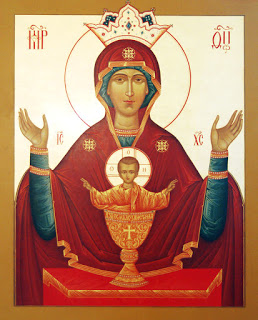
The suffering soldier, not being able to walk at all now, let alone such a long way, and being out of money, and with no one to help him, did not do as the staretz told him. The spiritual elder appeared to him in a second dream, but again he did not listen. Finally, the staretz came to him a third time in his dreams, and spoke to him so threateningly that at last the man set out on the road, crawling in the dirt as best he could. He eventually made it to a village, where he rested for the night, and there he met a kind-hearted old woman who rubbed his legs and laid him where the stove would warm him –which in an old Russian home was right atop the stove. That night he began to feel a pleasant sensation in his legs. By morning he found he could stand somewhat totteringly on his still-weak legs. He remained there, and by the next night he felt even better. So he again set off for the Serpukhov Monastery, this time walking with the aid of a stick. Thus, hobbling along, he made it all the way to the town of Serpukhov and to the monastery, but when he asked to hold a moleben before the icon of the “Unfailing Chalice,” nobody knew what he was talking about. No one had ever heard of such an icon there. But on looking about, someone found an icon in a side passage, and noticed that on the reverse of it was an inscription reading “The Unfailing Chalice.” The soldier realized that the staretz who appeared in his dream had been the Elder Varlaam, who had been the original founder of the Monastery in the 14th century. The “rediscovered” icon was carried into the church and a moleben was held before it.
Well, needless to say, the alcoholic ex-soldier went away healed, as the endings of all such stories go. Then news of the event was spread abroad, crowds began coming to pray before the image, copies were made of it, and a new Akathist (long prayer form) composed specially to that icon was written. And by the way, the motif of being told to do something three times, but only doing it on the third telling, as in this tale, is a not unusual motif in these origin stories of miracle-working icons, which in that respect are much like other folklore.
The prototype of this icon — at least the one associated with this story — is said to have been burned along with other icons in 1929, under the Communists. The revival of the veneration of this icon — in the form of copies painted in various styles — got under way in 1980. Those who began studying icons before that date but did not keep up on their studies will likely have never heard of it, because it is better known in E. Orthodoxy today than it ever was earlier, when its veneration was more localized in the Serpukhov region.
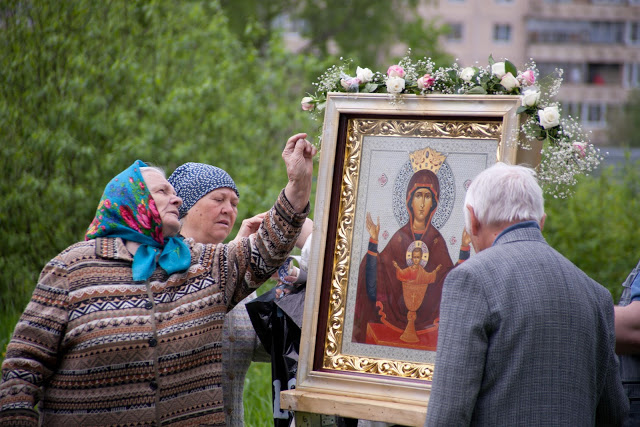
 The most popular of these types became so because the original was assumed to be chudotvornaya — “wonder-working,” meaning miracle-working. There are many stories and legends of miracles involving icons of Mary, and such “power” images were given respect beyond that given an ordinary icon, which accounts for the great number of copies made of them.
The most popular of these types became so because the original was assumed to be chudotvornaya — “wonder-working,” meaning miracle-working. There are many stories and legends of miracles involving icons of Mary, and such “power” images were given respect beyond that given an ordinary icon, which accounts for the great number of copies made of them.